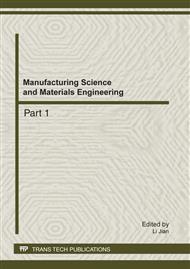p.576
p.583
p.589
p.594
p.601
p.607
p.612
p.617
p.622
Formation and Control of Cutting Direction Burr in Machining
Abstract:
In this paper, the forming processes, main effect factors and change law of the cutting direction burr in orthogonal cutting have been studied and related theories are analyzed based on the cutting experiments. The result shows that the forming processes of cutting direction burr consist of normal cutting, flexure deformation of end surface of workpiece, plastic effect, continuous cutting and shear-break separating in orthogonal cutting. And a new phenomenon was found that cutting direction burr is formed with the shear-break separation of the chip and workpiece machined surfaces. In addition, the size of cutting-direction burr varies with workpiece materials, cutting parameters and geometric parameters of cutting tool. The study may be important science and practical value in order to control and reduce cutting burr in precision machining.
Info:
Periodical:
Pages:
601-606
Citation:
Online since:
January 2012
Authors:
Price:
Сopyright:
© 2012 Trans Tech Publications Ltd. All Rights Reserved
Share:
Citation:


